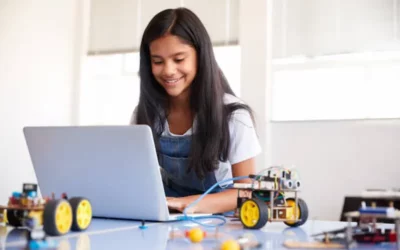Coding is a little like reading and writing. You can see where others have gone before, and you know it’s something that allows people to communicate ideas and thoughts in a way that is often artful.
Unlike other after-school activities, coding for kids is not expensive or time-consuming and teaches kids digital logic, problem-solving, computer programming, and an enormous amount of creative confidence while they learn!
As parents, we know how important it is for our kids to stay active, especially after school. If you’ve ever wanted to learn how to code but didn’t know how to get started, this post is for you.
You will know exactly how you can teach kids how to write code from scratch and show them the value of learning a skill that doesn’t require lengthy classes or advanced academic backgrounds. So, let’s get started!
Table of contents
- Introduction
- The Importance of Coding Skills in the 21st Century
- Coding as a Fun and Engaging After-School Activity
- Some examples of Coding Games, Projects, and Activities:
- How Coding Can Complement School Curriculum
- Coding Resources for After-School Activities
- Choosing the Best Coding Resources for Children
- Conclusion
- Frequently Asked Questions
Introduction
In today’s rapidly advancing world, technology plays a pivotal role in almost every aspect of our lives. As a result, coding has become an essential skill that empowers individuals to thrive in the digital age.
Recognizing the significance of early exposure to coding, many educators and parents have embraced coding as a perfect after-school activity for kids. In this response, we will explore why coding for kids is an ideal choice, highlighting the benefits and the reasons behind its popularity, some of the factors are –
1. Cultivating Problem-Solving Skills:
Coding involves breaking down complex problems into smaller, manageable parts and creating step-by-step solutions. By learning to code, children develop a structured approach to problem-solving. They learn to analyze challenges, think critically, and devise logical solutions, which are essential skills applicable to various real-life situations. This ability to think analytically and solve problems creatively can greatly benefit children academically and in their future careers.
2. Enhancing Computational Thinking:
Computational thinking is a fundamental skill that involves formulating problems and their solutions in ways that can be effectively processed by computers. Learning to code nurtures computational thinking in children. They develop the ability to break down problems, identify patterns, and think algorithmically. This skill set not only enables them to understand how computers work but also enhances their ability to think logically and approach tasks systematically.
3. Fostering Creativity and Innovation:
Coding provides a creative outlet for kids to express their imagination and turn their ideas into reality. Through coding, children can create their own games, animations, stories, and interactive projects. This creative aspect of coding encourages them to experiment, innovate, and think outside the box. Coding empowers children to become creators rather than just consumers of technology, sparking their creativity and nurturing their innovative thinking.
4. Developing Resilience and Persistence:
Coding is not always straightforward. It requires patience, perseverance, and the ability to handle setbacks and errors. When children encounter bugs or face challenges in coding, they learn to debug and troubleshoot, developing resilience and persistence along the way. These skills are essential in all areas of life, teaching kids to embrace challenges, learn from failures, and persist in their pursuit of solutions.
5. Building Collaboration and Teamwork Skills:
In today’s interconnected world, collaboration and teamwork are vital skills. Coding often involves working on projects together, encouraging children to collaborate, share ideas, and solve problems collectively. They learn how to communicate effectively, respect others’ perspectives, and work as part of a team. These collaborative experiences in coding lay a foundation for successful collaboration in future academic and professional endeavors.
6. Opening Pathways to Future Opportunities:
The demand for individuals with coding and technology skills is rapidly growing across various industries. By introducing coding to children early on, we provide them with a head start in preparing for the digital future. Whether they pursue careers in technology or not, coding equips them with transferable skills such as logical thinking, problem-solving, and creativity, which are highly valued in the job market.
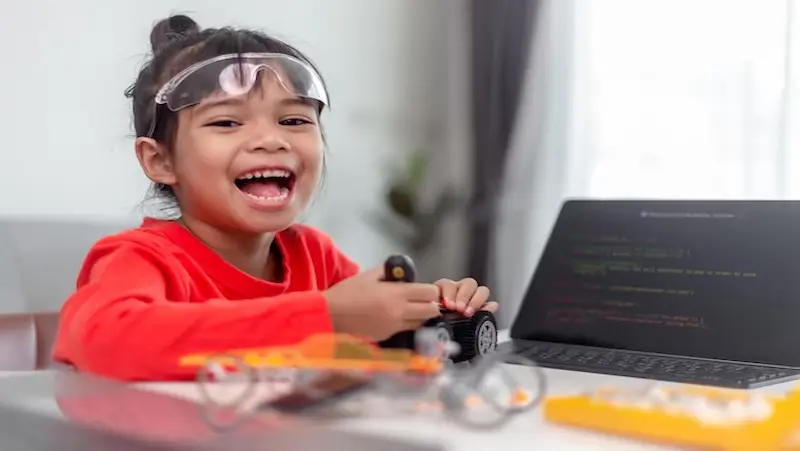
The Importance of Coding Skills in the 21st Century
In the 21st century, coding skills have become increasingly important due to the rapid growth and integration of technology in nearly every aspect of our lives. Here are several key reasons highlighting the importance of coding skills in the current digital age:
1. Future-Proofing Career Opportunities: As technology continues to advance, the job market is shifting towards automation and digitalization. Proficiency in coding opens up a wide range of career opportunities in fields such as software development, data analysis, artificial intelligence, cybersecurity, web development, and more. By acquiring coding skills, individuals can position themselves for success in a technology-driven job market and future-proof their career prospects.
2. Navigating the Digital World: Coding skills empower individuals to navigate and understand the digital world we live in. From mobile apps to websites, from smart devices to online platforms, the ability to code allows individuals to comprehend the underlying mechanisms and make informed decisions. It promotes digital literacy and empowers individuals to leverage technology effectively, rather than being passive consumers.
3. Critical Thinking and Problem-Solving: Coding fosters problem-solving skills and critical thinking skills for kids. When coding, individuals encounter various challenges and obstacles that require analytical thinking and logical reasoning to overcome. They learn to break down complex problems into manageable parts, identify patterns, and devise step-by-step solutions. These problem-solving skills are highly transferable and valuable in diverse contexts, whether in academic, professional, or personal life.
4. Enhancing Creativity and Innovation: Coding is a powerful tool for creativity and innovation. It allows individuals to bring their ideas to life by creating software, applications, games, and interactive projects. Through coding, individuals can express their imagination, experiment with different solutions, and innovate in various fields. Whether it’s a unique website maker for kids designing, developing a mobile app, or building a robotic system, coding unleashes creativity and enables individuals to contribute to the digital landscape.
5. Collaboration and Teamwork: Coding is not solely an individual pursuit. It often involves working collaboratively on projects, sharing ideas, and solving problems together. Learning to code cultivates collaboration and teamwork skills, as individuals engage in discussions, provide feedback, and contribute to the collective development of software or applications. Collaboration in coding projects mirrors real-world team dynamics and prepares individuals for collaborative work environments.
6. Understanding Technology’s Impact on Society: Technology has a profound impact on society, influencing everything from communication and education to healthcare and transportation. By learning to code, individuals gain a deeper understanding of how technology works, its potential benefits, and its societal implications. This knowledge empowers individuals to be informed digital citizens who can make ethical decisions, contribute to technological advancements responsibly, and address the challenges and opportunities presented by technology in society.
In all, coding skills are vital in the current digital age due to their impact on career opportunities, digital literacy, critical thinking, creativity, collaboration, and understanding of the societal implications of technology. By acquiring coding skills, individuals can actively participate in the digital world, adapt to technological advancements, and contribute to shaping the future.

Coding as a Fun and Engaging After-School Activity
Coding can be a highly enjoyable and engaging after-school activity for kids. Here are some reasons why coding is fun & some best coding games for kids, projects, and activities that kids can enjoy:
1. Creative Expression: Coding allows children to unleash their creativity by creating games, animations, stories, and interactive projects. They can bring their ideas to life and personalize their creations, adding their unique touch and style.
2. Gamification: Many coding platforms and tools incorporate gamification elements, turning the learning process into a fun and interactive experience. Kids can earn points, unlock levels, and receive rewards as they progress, making coding feel like a game.
3. Problem Solving and Challenges: Kids enjoy the thrill of solving puzzles and overcoming challenges. Coding presents various problem-solving opportunities, such as debugging code, finding solutions to programming challenges, or creating algorithms to accomplish specific tasks.
4. Collaborative Projects: Coding activities often encourage teamwork and collaboration. Kids can engage in joint projects where they work together to create games, websites, or interactive stories. Collaboration fosters social interaction and adds an extra layer of enjoyment to the coding experience.
Are you aware BrightChamps has an extraordinary coding program called CodeChamps that ignites young minds with the power of coding through an engaging curriculum? It is a creative wonderland where kids dive into the captivating world of programming, learning to unravel complex algorithms and craft their own digital masterpieces.
To get your hands on more such educational and free resources on coding, robotics, game development, etc., do check out the Brightchamps Blog Page now!
Some examples of Coding Games, Projects, and Activities:
1. Scratch: Scratch is a visual programming language that allows kids to create interactive stories, animations, and games. They can design their characters, program their behaviors, and share their creations with others in the Scratch community.
2. Code.org: Code.org offers a variety of coding activities, including puzzle-based games like “Minecraft Hour of Code” or “Frozen Code Tutorial.” These games feature popular characters and provide step-by-step coding challenges in a fun and engaging manner.
3. Robotics: Robotics kits, such as LEGO Mindstorms or VEX Robotics, enable kids to build and program their own robots. They can explore the world of robotics, experiment with sensors and motors, and code their robots to perform specific tasks or compete in challenges.
4. Web Development: They can learn HTML for kids, CSS, and JavaScript to create their own websites. They can build personal blogs, showcase their artwork, or create interactive web pages with animations and games.
5. App Development: With platforms like MIT App Inventor or Swift Playgrounds, kids can learn to develop their own mobile applications. They can design and code apps that solve real-world problems or create games that they can play and share with friends.
6. Game Development: Tools like Unity or GameMaker Studio allow kids to design and code their own video games. They can create characters, levels, and gameplay mechanics, bringing their imaginative worlds to life.
7. Arduino Projects: Arduino is an open-source electronics platform that enables kids to build and program their own electronic devices. They can create light-up wearables, smart home prototypes, or interactive gadgets controlled by code.
These examples illustrate the wide range of coding activities that kids can enjoy as after-school projects. By exploring these creative and interactive coding experiences, children can have fun while developing valuable skills in problem-solving, logic, creativity, and collaboration.
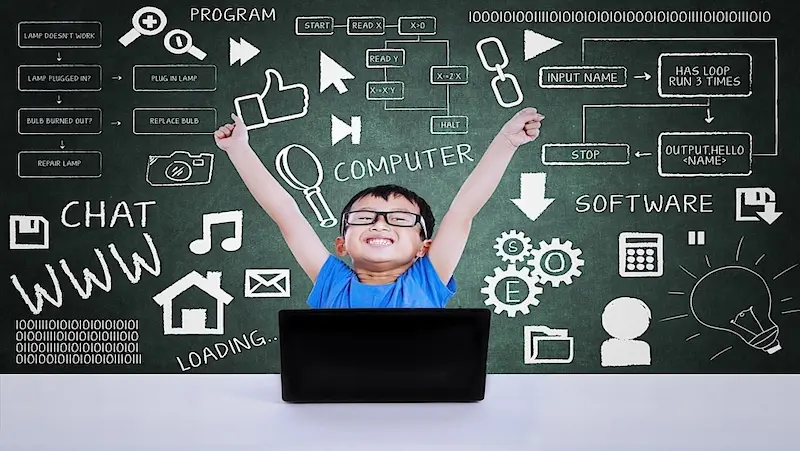
How Coding Can Complement School Curriculum
Coding can significantly complement the school curriculum and enhance children’s academic performance. Here’s a brief overview of how coding contributes to these areas:
1. Problem-Solving Skills: Coding requires children to break down complex problems into smaller, more manageable parts. They learn to analyze challenges, identify patterns, and develop step-by-step solutions. This approach to problem-solving transfers to other subjects, empowering children to tackle academic problems more effectively.
2. Critical Thinking: Coding promotes critical thinking as children evaluate different options, anticipate potential outcomes, and make informed decisions. They learn to identify logical sequences, evaluate cause-and-effect relationships, and debug their code when errors occur. These critical thinking skills transfer to other academic areas, enabling children to approach challenges analytically and think more strategically.
3. Creativity: Coding provides an outlet for creativity and encourages children to think innovatively. Through coding, they can design and develop their own games, stories, and interactive projects. This process involves making creative choices, experimenting with different solutions, and expressing their unique ideas. The ability to think creatively extends beyond coding and supports children in various artistic, writing, and problem-solving endeavors.
4. Integration of Concepts: Coding integrates various concepts from multiple subjects, fostering interdisciplinary learning. For example, while coding a game, children apply mathematical concepts such as coordinates, angles, and variables. They can incorporate language arts by writing narratives for their projects or explore scientific principles through coding simulations. This integration strengthens their understanding of different subjects and promotes a holistic approach to learning.
5. Attention to Detail and Accuracy: Coding requires attention to detail and precision. Children learn to write accurate code, ensuring that every character and syntax is correct. This attention to detail carries over to their academic work, encouraging them to be meticulous in tasks that require accuracy, such as math calculations, writing essays, or conducting scientific experiments.
6. Project-Based Learning: Coding often involves project-based learning, where children work on coding projects from start to finish. This hands-on approach engages them in active learning, allowing them to apply their knowledge in a practical context. By completing coding projects, children develop research skills, time management, and presentation abilities, all of which contribute to their overall academic performance.
By incorporating coding into the school curriculum, educators can tap into these benefits and enhance children’s problem-solving, critical thinking, and creativity skills. Coding provides a practical and engaging platform for students to apply and reinforce their learning from various subjects, making their academic journey more interactive and meaningful.

Coding Resources for After-School Activities
Coding Resources for After-School Activities are as follows:
1. Coding Bootcamp for kids: Local coding boot camps, clubs or community centers often offer after-school coding programs for kids where they can learn and code together in a supportive environment. These clubs provide hands-on projects, mentorship, and opportunities for collaboration.
2. Online Courses and Platforms: Numerous online platforms offer coding courses and tutorials tailored for kids. Code.org, Khan Academy, Scratch, and Tynker are popular examples. These platforms provide interactive lessons, coding challenges, and projects that kids can engage with at their own pace.
3. Coding Toys and Kits: Coding toys and kits make learning to code more interactive and engaging. Products like LEGO Boost, Sphero, Ozobot, and littleBits allow children to build and program robots or create interactive projects using coding concepts.
4. Coding Apps and Games: There are many coding apps and code games for kids available to learn coding in a playful way. Examples include Lightbot, CodeSpark, and Kodable, which introduce programming concepts through gamified challenges and puzzles.
Choosing the Best Coding Resources for Children
1. Consider Age and Skill Level: Select coding resources appropriate for your child’s age and skill level. Look for resources specifically designed for kids, offering age-appropriate content and a gradual progression of difficulty.
2. Interactive and Engaging: Choose resources that are interactive and engaging to maintain your child’s interest. Look for platforms or tools that incorporate gamification, visual programming, and hands-on activities to make learning coding enjoyable.
3. Clear Instructions and Support: Ensure the coding resources provide clear instructions, tutorials, and support materials. Look for platforms or courses that offer step-by-step guidance, video demonstrations, and forums where kids can seek help or connect with mentors.
4. Balance Learning and Fun: Find coding resources that strike a balance between learning and fun. Look for resources that encourage creativity, allow for personalization, and offer opportunities for kids to express their ideas and interests through coding projects.
5. Reviews and Recommendations: Read reviews and seek recommendations from other parents or educators to get insights into the effectiveness and quality of coding resources. Consider feedback regarding the user experience, curriculum content, and overall satisfaction of other users.
6. Flexibility and Accessibility: Consider the flexibility and accessibility of the coding resources. Look for platforms or tools that can be accessed from various devices (computers, tablets, etc.) and offer the flexibility to accommodate your child’s schedule and learning preferences.
By considering these factors, parents can choose coding resources that align with their child’s interests, learning style, and skill level, maximizing the benefits and enjoyment of after-school coding activities.
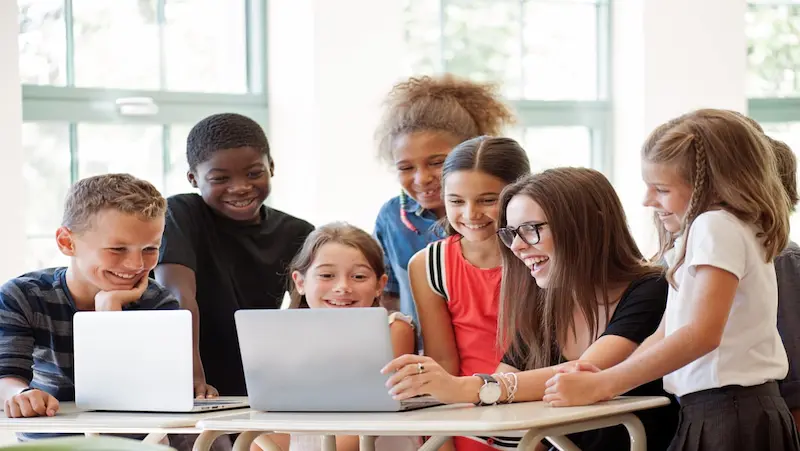
Conclusion
Coding is an ideal after-school activity for kids due to its numerous benefits. It fosters problem-solving skills, enhances computational thinking, promotes creativity, develops resilience, and nurtures collaboration.
Moreover, coding equips children with essential skills for the future, opening doors to various career opportunities. By engaging in coding at a young age, children can develop valuable skills that will serve them well throughout their lives, empowering them to thrive in an increasingly digital world.
Frequently Asked Questions
Coding is the process of creating instructions for computers to follow. It is important for kids to learn to code as it develops problem-solving skills, critical thinking, and creativity while preparing them for the digital future.
Kids can start learning to code as early as age 5 or 6, through age-appropriate resources and tools that introduce coding concepts in a playful and interactive manner.
Teaching kids how to code offers benefits such as developing problem-solving skills, promoting logical thinking, fostering creativity, enhancing critical thinking, and preparing them for future career opportunities in a digital world.
Some fun and engaging coding activities for kids include creating their own games and animations using Scratch, building and coding robots, designing Coding for kids websites, and solving coding puzzles and challenges.
Scratch and Blockly are popular programming languages for kids due to their visual and block-based nature, making coding concepts accessible and enjoyable. Python is also recommended for its versatility and readability.
Some of the best online resources for kids to learn coding include Code.org, Scratch, Khan Academy, Tynker, and Blockly Games, offering interactive lessons, coding projects, and games suitable for young learners.
Parents and teachers can encourage and support kids interested in coding by providing access to coding resources, enrolling them in coding classes for kids near you or clubs, celebrating their achievements, and fostering a supportive and explorative environment.
Coding skills can be applied to real-world problems by developing software solutions, automating tasks, analyzing data, and creating technologies for various fields, such as healthcare, transportation, climate change, and cybersecurity.
Coding skills can benefit kids in their future careers by opening up opportunities in technology-related fields, fostering problem-solving abilities, promoting creativity, and enhancing critical thinking and logical reasoning skills.
Some common misconceptions about coding for kids include it being too difficult or only for u0022tech-savvyu0022 children. These misconceptions can be addressed by providing age-appropriate resources, emphasizing the creativity and problem-solving aspects of coding, and offering supportive guidance and encouragement.

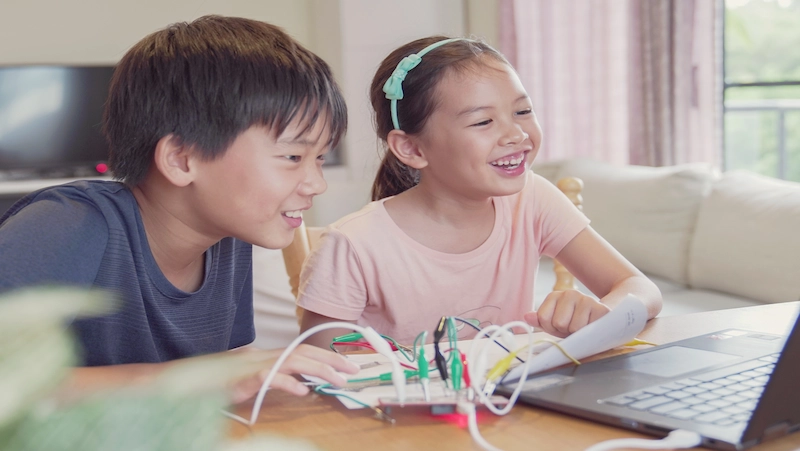
 We are an army of educators and passionate learners from BrightChamps family, committed to providing free learning resources to kids, parents & students.
We are an army of educators and passionate learners from BrightChamps family, committed to providing free learning resources to kids, parents & students.





